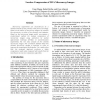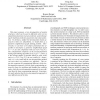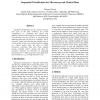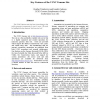CSB
2005
IEEE
14 years 5 months ago
2005
IEEE
Our paper describes the first provably-efficient algorithm for determining protein structures de novo, solely from experimental data. We show how the global nature of a certain ...
CSB
2005
IEEE
14 years 5 months ago
2005
IEEE
Understanding the relationship between protein structure and its sequence is one of the most important tasks of current bioinformatics research. In this work, recurring protein se...
CSB
2005
IEEE
14 years 5 months ago
2005
IEEE
Studying the genetic control of molecular, anatomical and/or morphological phenotypes in model organisms is a powerful tool in the functional analysis of a gene. The goal of our r...
CSB
2005
IEEE
14 years 5 months ago
2005
IEEE
Annotation of protein function often arises in the context of partially complete genomes but is not adequately addressed. We present an annotation method by extracting ortholog cl...
CSB
2005
IEEE
14 years 5 months ago
2005
IEEE
Microarray experiments are characterized by a massive amount of data, usually in the form of an image. Based on the nature of microarray images, we consider the microarray in term...
CSB
2005
IEEE
14 years 5 months ago
2005
IEEE
CSB
2005
IEEE
14 years 5 months ago
2005
IEEE
Sequential classification uses in a stepwise process only part of the data (evidence) for partial classification, i.e., classifying only objects with sufficient evidence and leavi...
CSB
2005
IEEE
14 years 5 months ago
2005
IEEE
High throughput expression profiling and genotyping technologies provide the means to study the genetic determinants of population variation in gene expression variation. In this ...
CSB
2005
IEEE
14 years 5 months ago
2005
IEEE
The UCSC Genome site has been contributing to the public genomics community for over 5 years. We wish to highlight the key features, both new and old.
CSB
2005
IEEE
14 years 5 months ago
2005
IEEE
In the feature selection of cancer classification problems, many existing methods consider genes individually by choosing the top genes which have the most significant signal-to...




